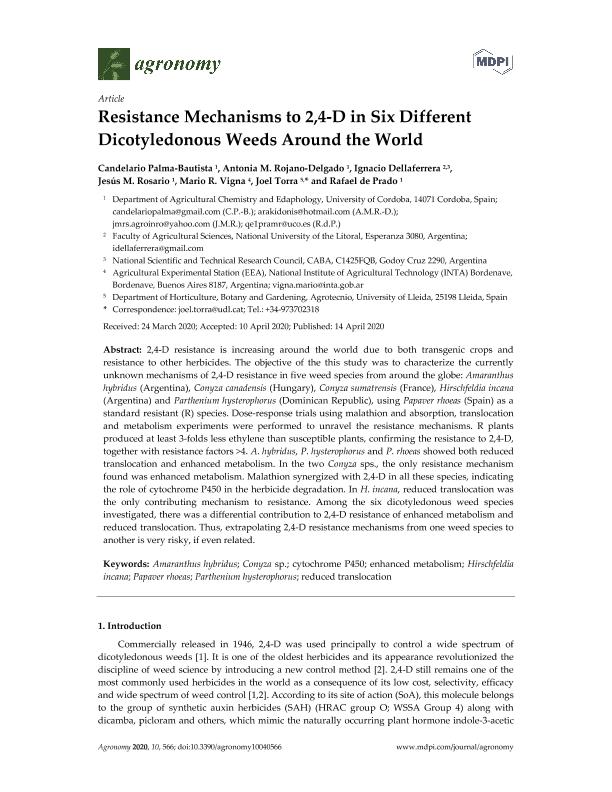Artículo
Resistance mechanisms to 2,4-D in six different dicotyledonous weeds around the world
Palma Bautista, Candelario; Rojano Delgado, Antonia María; Dellaferrera, Ignacio Miguel ; Rosario, Jesus; Vigna, Mario Raul; Torra, Joel; De Prado, Rafael
; Rosario, Jesus; Vigna, Mario Raul; Torra, Joel; De Prado, Rafael
 ; Rosario, Jesus; Vigna, Mario Raul; Torra, Joel; De Prado, Rafael
; Rosario, Jesus; Vigna, Mario Raul; Torra, Joel; De Prado, Rafael
Fecha de publicación:
04/2020
Editorial:
MDPI AG
Revista:
Agronomy
ISSN:
2073-4395
Idioma:
Inglés
Tipo de recurso:
Artículo publicado
Clasificación temática:
Resumen
2,4-D resistance is increasing around the world due to both transgenic crops and resistance to other herbicides. The objective of the this study was to characterize the currently unknown mechanisms of 2,4-D resistance in five weed species from around the globe: Amaranthus hybridus (Argentina), Conyza canadensis (Hungary), Conyza sumatrensis (France), Hirschfeldia incana (Argentina) and Parthenium hysterophorus (Dominican Republic), using Papaver rhoeas (Spain) as a standard resistant (R) species. Dose-response trials using malathion and absorption, translocation and metabolism experiments were performed to unravel the resistance mechanisms. R plants produced at least 3-folds less ethylene than susceptible plants, confirming the resistance to 2,4-D, together with resistance factors >4. A. hybridus, P. hysterophorus and P. rhoeas showed both reduced translocation and enhanced metabolism. In the two Conyza sps., the only resistance mechanism found was enhanced metabolism. Malathion synergized with 2,4-D in all these species, indicating the role of cytochrome P450 in the herbicide degradation. In H. incana, reduced translocation was the only contributing mechanism to resistance. Among the six dicotyledonous weed species investigated, there was a differential contribution to 2,4-D resistance of enhanced metabolism and reduced translocation. Thus, extrapolating 2,4-D resistance mechanisms from one weed species to another is very risky, if even related.
Archivos asociados
Licencia
Identificadores
Colecciones
Articulos(CCT - SANTA FE)
Articulos de CTRO.CIENTIFICO TECNOL.CONICET - SANTA FE
Articulos de CTRO.CIENTIFICO TECNOL.CONICET - SANTA FE
Citación
Palma Bautista, Candelario; Rojano Delgado, Antonia María; Dellaferrera, Ignacio Miguel; Rosario, Jesus; Vigna, Mario Raul; et al.; Resistance mechanisms to 2,4-D in six different dicotyledonous weeds around the world; MDPI AG; Agronomy; 10; 4; 4-2020; 1-11
Compartir
Altmétricas



